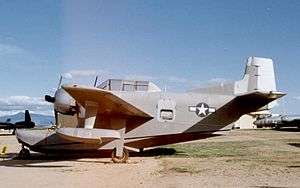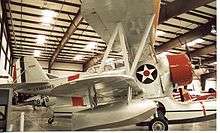Columbia Aircraft Corporation
| Aircraft and component manufacturer | |
| Industry | aircraft |
| Fate | operations acquired post 1947 by Commonwealth Aircraft |
| Founded | 1927 |
| Defunct | c1947 |
| Headquarters | Hempstead, New York |
Key people | Charles A. Levine and Giuseppe Mario Bellanca |
The Columbia Aircraft Corporation was a United States aircraft manufacturer, which was active between 1927 and 1947.
Formation and operations
Columbia Aircraft was founded in December 1927 by Charles A. Levine as chairman and the aircraft designer Giuseppe Mario Bellanca as president. The initial name used was Columbia Air Liners Inc.[1] The aircraft factory was established at Hempstead, New York. Levine hired pilots Bert Acosta, Eroll Boyd, John Wycliff Isemann, Burr Leyson, and Roger Q. Williams at $200 a week to perfdorm a series of publicity record attempts for the company.[2]
The most ambitious project for the company was the "Uncle Sam". The $250,000 prototype was brought to market at the height of the depression. It was sold at auction for $3000 to pay back hangar rent. The "Uncle Sam" and two other Triads was destroyed shortly afterward in a Roosevelt Field hangar fire where 20 other aircraft were spared.[3]
By 1941, the firm's title was Columbia Aircraft Corporation and the factory was located at Valley Stream, Long Island.[4]

From 1941, Columbia worked closely with Grumman Aircraft, undertaking the development and production of that company's military amphibian aircraft designs including the J2F Duck[4] and the Columbia JL.
After the completion of wartime contracts for the United States Navy, the firm's operations reduced in scale and Columbia was acquired by Commonwealth Aircraft circa 1948.
Aircraft
(Data from Aerofiles)
- Wright-Bellanca WB-2 Columbia: The sole example built in 1926 and bought from Wright Aeronautical, The Columbia was a multiple world record holding aircraft designed by Bellanca that was originally considered for use by Charles Lindberg in his transatlatic flight of 1927. Bellanca took the rights to the aircraft when he left the company, making the CH series of aircraft based on the design.
- Single-seat open cockpit high-wing monoplane: Unnamed design powered by a 40 h.p. Salmson engine, 1 built in 1929.

- CAL-1 Triad: Six passenger closed cabin high-wing monoplane. Powered by a 220 h.p. Wright J-5. Span 40 ft. Length 33 ft. Convertible to amphibian or seaplane. 2 built in 1929. Both destroyed in a factory fire in January 1931.
- Uncle Sam: Closed cockpit high-wing monoplane with a 450 h.p. Packard 2A engine. Span 60 ft with 1400 gallon gas tanks.[5] Single development aircraft for a planned 50-passenger transoceanic transport. Test flown in 1930 using water ballast in long range tanks, logging twelve flights[6] but found to be under-powered. Destroyed January 1931 hangar fire with engine and instruments removed.
- Grumman J2F-6 Duck: Single-engine amphibian biplane for the U.S. Navy. 330 built under sub-contract to Grumman Aircraft in 1941/42.
- Columbia JL: Single-engine monoplane amphibian for the U.S. Navy. 3 built in 1946, 1 being used in destructive static tests.
References
Notes
- ↑ Aerofiles
- ↑ Ross Smyth. The Lindbergh of Canada: the Erroll Boyd story.
- ↑ "Suspect in Arson Fire". The Meriden Daily Journal. 30 January 1931.
- 1 2 Swanborough, 1990, p. 221
- ↑ Meriden Record. 28 January 1931. Missing or empty
|title=(help) - ↑ "LEVINE PLANES TO BE SOLD; Default Judgment Obtained Against His Air Line". The New York Times. 9 January 1931.
Bibliography
- Swanborough, Gordon (1990). United States Navy Aircraft since 1911. Naval Institute Press. ISBN 0-87021-792-5.